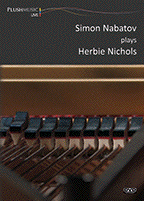

"Simon Nabatov plays Herbie Nichols"DVD PanRec 2010
Touching Extremes November 2010 Simon Nabatov is a gentle bear of a man who seems to struggle a bit when forced to put the quintessence of music and inspiration in plain words. But, when turning to the piano keyboard, his fingers do all the necessary talking, shutting an enraptured audience up in the process. A child prodigy born in Moscow in 1959, Nabatov is a classically trained instrumentalist, a phenomenal technique gradually developed in long years of study at prestigious schools such as New York's Juilliard. Once in the Big Apple, suddenly young Simon's horizon began to expand and include myriads of different interests and influences (one of the most important being Paul Bley). Having to choose, he dedicated himself to jazz and improvisation completely, ultimately starting a career that has seen him performing with a literal who's who of illustrious names: Paul Motian, Kenny Wheeler, Phil Minton, Han Bennink, Misha Mengelberg, and many others. Nabatov became interested in Herbie Nichols's work by listening to Mengelberg's interpretations and to trombonist Roswell Rudd, a pupil and collaborator of the influential composer (largely famous for penning the evergreen ‚"Lady Sings The Blues". In this concert, recorded at Cologne's Loft in 2009, the pianist tackles that and other songs by the same author - among them, ‚"2300 Skiddoo", "Twelve Bars" and the magnificent "Terpsichore"‚- with disciplined fervor and impressive harmonic command. In the short segment (added as a bonus feature in the DVD) where the Russian explains his improvisational concept, he refers to a kind of ‚"mental library" of elements to draw from when the occasion is right and to the alertness maintained during the impromptu analysis of the tunes, in order to catch every suggestion ‚"with the aerials raised". This is very clear to see over the whole set: the hands don't play a wrong note throughout, and their owner's face is a joy to contemplate in its alternance of closed-eyes smiles and ecstatic strenuousness. The film - shot by Plush Music and produced by Hayden Chisholm - masterfully shifts the focus from theartist's physical and technical expressions to the insides of the instrument, finely emphasizing the character of Nabatov's logically zealous renditions while giving us a chance of watching the soul of a sensitive musician exposed. This gentleman has made the search for the perfect equilibrium between thrill and sophistication a raison d'étre. This full hour of awesome playing combines the best of two worlds, the notion of virtuosity - an unpronounceable word in these days of inaudible scrape-and-hiss and artificial posturing - associated to the performer's ever-cogent infatuation for the material. Nichols, who died prematurely in 1963 of leukemia, is certainly nodding a convinced approval. Massimo Ricci |
Jazz Podium December 2011 ... Sensibel und dominant, perkussiv und melodiös fließen musikalische Gedanken Nichols' wie das Lebenselixier des Kammerjazz aus dem Körper von Simon Nabatov, der die Aufregung und die Kultiviertheit dieser Musik wie eine plastische Skulptur zu illustrieren weiß. Klaus Hübner |
The New York City Jazz Record May 2012 Nabatov’s approach to Nichols is fascinating. He mostly sticks with material the pianist recorded for Blue Note in the mid 50s and at some point or other in each performance makes a reasonably literal reference to how the tune is played. But the way he takes off from them is less straightforward; he doesn’t follow the structures, as most musicians would, so much as construct dense collages with the harmonic, melodic and rhythmic elements. And the longer one spends with the video, the more sense Nabatov’s approach makes. After all, Nichols as an improviser was less involved with creating new melody than in constantly playing off the original theme and Nabatov extends this idea. Nabatov repeats passages, stretches them out, rearranges, rephrases and adds his own riff figures that he uses to great advantage, often as a way into the compositions. He shows us side-paths we hadn’t known of and it’s obvious watching him that he’s still making new discoveries himself. Nabatov illuminates aspects of Nichols’ thinking that others have neglected, no mean achievement. Dan Baker |
Jazzthetik December 2011 "... Mitscnitt eines Konzertes, in dem Simon Nabatov dem Jazz-pianisten und - komponisten Herbie Nichols Reverenz erweist.... es macht Vergnügen, das Tastengenie Nabatov brillieren zu sehen und zu hören..." hAltma |
All About Jazz Italy December 2011 ***** Fin dalle prime note si capisce chiaramente che questo concerto in solitudine del talentuoso Simon Nabatov ha qualcosa di speciale e di unico. Il suo svetta come il migliore omaggio discografico che nell'ultimo decennio il jazz ha dedicato ad Herbie Nichols. Chi meglio del virtuoso pianista russo avrebbe potuto rappresentare il lato "oscuro" della logica compositiva nicholsiana, fatto di echi atonali e bartockiani? Maurizio Zerbo |